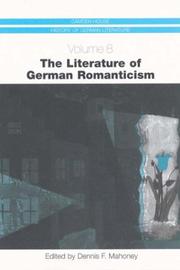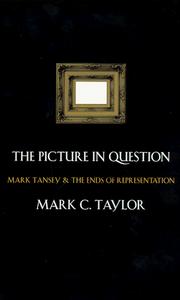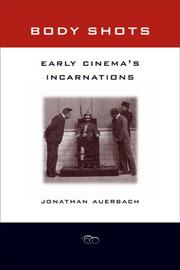Book
ISBN: 1942954220 1942954212 9781942954224 9781942954217 Year: 2016 Publisher: Liverpool
Abstract | Keywords | Export | Availability | Bookmark
 Loading...
Loading...Choose an application
- Reference Manager
- EndNote
- RefWorks (Direct export to RefWorks)
In addition to being a major twentieth-century author, John Dos Passos painted, principally in watercolor, throughout his career. This book reproduces 68 examples of Dos Passos's art, almost all in full color, presented in two parts containing 13 sections. In Part One, each section is devoted to a similar kind of art work produced within a specific time frame; in Part Two, each section consists of work in a specific genre. The book also includes essays devoted to the history and nature of Dos Passos' work as a pictorial artist and to the relationship of this work to his novels. It concludes with a survey of Dos Passos art collections, exhibitions, and previous published illustrations and paintings. The book as a whole seeks to demonstrate that Dos Passos's lifelong commitment to and practice of pictorial representation are vital aspects of his career because they confirm and manifest in both verbal and visual stylistics such modernist tendencies as Fauvism, Cubism, and Expressionism. Both the essays and illustrations in this book argue for the importance of Dos Passos's paintings as keys to fully understanding the writer's complex body of work and, in their striking compositions and vibrant colors, as challenging objects of visual pleasure in their own right.
Dos Passos, John, --- Passos, John Dos, --- Dos Passos, Dzhon, --- Passos, Dzhon Dos, --- דוס פסוס, ג׳ון --- Criticism and interpretation. --- Cubism --- visual art --- Expressionism --- painting-fiction interarts --- Dos Passos art work --- modernism
Book
Year: 2020 Publisher: Open Book Publishers
Abstract | Keywords | Export | Availability | Bookmark
 Loading...
Loading...Choose an application
- Reference Manager
- EndNote
- RefWorks (Direct export to RefWorks)
"The idea that the digital age has revolutionized our day-to-day experience of the world is nothing new, and has been amply recognized by cultural historians. In contrast, Stephen Robertson’s BC: Before Computers is a work which questions the idea that the mid-twentieth century saw a single moment of rupture. It is about all the things that we had to learn, invent, and understand – all the ways we had to evolve our thinking – before we could enter the information technology revolution of the second half of the twentieth century. Its focus ranges from the beginnings of data processing, right back to such originary forms of human technology as the development of writing systems, gathering a whole history of revolutionary moments in the development of information technologies into a single, although not linear narrative.Treading the line between philosophy and technical history, Robertson draws on his extensive technical knowledge to produce a text which is both thought-provoking and accessible to a wide range of readers. The book is wide in scope, exploring the development of technologies in such diverse areas as cryptography, visual art and music, and the postal system. Through all this, it does not simply aim to tell the story of computer developments but to show that those developments rely on a long history of humans creating technologies for increasingly sophisticated methods of manipulating information.Through a clear structure and engaging style, it brings together a wealth of informative and conceptual explorations into the history of human technologies, and avoids assumptions about any prior knowledge on the part of the reader. As such, it has the potential to be of interest to the expert and the general reader alike."
Computing & information technology --- Information theory --- Educational equipment & technology, computer-aided learning (CAL) --- Biography & True Stories --- Information technology: general issues --- history of computer developments --- digital age --- computer --- information technology revolution --- data processing --- cryptography --- visual art --- music --- postal system
Book
ISBN: 1479808210 Year: 2022 Publisher: New York : New York University Press,
Abstract | Keywords | Export | Availability | Bookmark
 Loading...
Loading...Choose an application
- Reference Manager
- EndNote
- RefWorks (Direct export to RefWorks)
"This is the first book-length project to examine the relationship between blackness, queerness, and hip hop. Using aesthetics as its organizing lens, Hip Hop Heresies attends to the ways that hip hop cultural production in New York City from the 1970s through the first fifteen years of the 21st century produced hip hop cultural products (film, visual art, and music) that offer "queer articulations" of race, gender, and sexuality that are contrary to hegemonic ideas and representations of those categories in hip hop production, as well as in writing about hip hop culture"--
Aesthetics, Black. --- African American arts --- Gay culture --- Hip-hop --- History. --- New York (State) --- 1990s. --- Aesthetics. --- Afro Asian. --- Berry Gordy's The Last Dragon. --- Black aesthetics. --- Black masculinity. --- Black women. --- Blackness. --- Brooklyn. --- Chinest. --- Film. --- Graffiti. --- Hip Hop. --- Jean Grae. --- LGBTQ. --- Lil Nas X. --- Lower East Side. --- Man Parrish. --- Martin Wong. --- Museum of American Graffiti. --- Music. --- New York City. --- Queer hip hop. --- Queer. --- Visual Art. --- archival. --- dance. --- ethnography. --- film. --- future. --- gay hip hop. --- gay rappers. --- hip hop aesthetics. --- martial arts. --- music. --- psychoanalysis. --- queer aesthetics. --- rap music. --- trans. --- uncanny. --- visual art.

ISBN: 9781571132369 1571132368 9781571136244 9786611770594 1281770590 157113624X Year: 2004 Volume: 8 Publisher: Suffolk Boydell & Brewer
Abstract | Keywords | Export | Availability | Bookmark
 Loading...
Loading...Choose an application
- Reference Manager
- EndNote
- RefWorks (Direct export to RefWorks)
This volume of sharply focused essays by an international team of scholars deals not only with the most significant literary, philosophical, and cultural aspects of German Romanticism - one of the most influential, albeit highly controversial movements in the history of German literature - but also with the history and status of scholarship on the literature of the period. The introduction and first section establish an overall framework by placing German Romanticism within a European context that includes its English counterpart. Goethe and Schiller are considered, as are the Jena Romantics. The second section is organized according to the traditional distinctions between epic, dramatic, and lyric modes of writing, while realizing that particularly in the Romantic novel, there was an attempt to blend these three. A final group of essays focuses on German literary Romanticism's relation to other aspects of German culture: folklore studies, politics, psychology, natural science, gender presentation and representation, music, and visual art. Contributors: Gerhard Schulz, Arnd Bohm, Richard Littlejohns, Gerhart Hoffmeister, Ulrich Scheck, Claudia Stockinger, Bernadette Malinowski, Fabian Lampart, Klaus Peter, Gabriele Rommel, Martha B. Helfer, Kristina Muxfeldt, Beate Allert, Paul Bishop and R. H. Stephenson, Nicholas Saul. Dennis F. Mahoney is Professor of German and Director of the European Studies Program at the University of Vermont.
German literature --- Romanticism --- History and criticism. --- Young Germany --- History and criticism --- Arnd Bohm. --- Dennis F. Mahoney. --- European context. --- Gerhard Schulz. --- German Romanticism. --- Goethe. --- Jena Romantics. --- Richard Littlejohns. --- Schiller. --- University of Vermont. --- cultural aspects. --- dramatic. --- epic. --- folklore studies. --- gender. --- literary. --- lyric modes. --- music. --- natural science. --- philosophical. --- politics. --- psychology. --- visual art.
Book
ISBN: 9781526125149 9781847795052 9780719094934 0719094933 1847795056 9780719075636 0719075637 1526125145 0719085608 Year: 2009 Publisher: Manchester Manchester University Press
Abstract | Keywords | Export | Availability | Bookmark
 Loading...
Loading...Choose an application
- Reference Manager
- EndNote
- RefWorks (Direct export to RefWorks)
This electronic version has been made available under a Creative Commons (BY-NC-ND) open access license. This is a distinctive book that examines the diversity and energy of writing in a period marked by the unparalleled global prominence of Irish culture.This collection provides a wide-ranging survey of fiction, poetry and drama over the last two decades, considering both well-established figures and also emerging writers who have received relatively little critical attention. Contributors explore the central developments within Irish culture and society that have transformed the writing and reading of identity, sexuality, history and gender. The book examines the impact of Mary Robinson's Presidency; growing cultural confidence 'back home'; legislative reform on sexual and moral issues; the uneven effects generated by the resurgence of the Irish economy (the 'Celtic Tiger' myth); Ireland's increasingly prominent role in Europe; and changing reputation.In its breadth and critical currency, this book will be of particular interest to academics and students working in the fields of literature, drama and cultural studies.
English literature --- Irish literature --- National characteristics, Irish, in literature. --- Irish authors --- History and criticism. --- Ireland --- In literature. --- History --- Literature --- Literary Criticism --- Eiléan Ní Chuilleanáin. --- Irish Republic. --- Irish autobiography. --- Irish drama. --- Irish fiction. --- Irish identity. --- Irish poetry. --- Irish politics. --- Irish theatre. --- Roddy Doyle. --- Vona Groarke. --- geopolitical concern. --- globalisation. --- visual art.

ISBN: 1282538861 9786612538865 0226791270 9780226791272 9780226791289 0226791289 9780226791296 0226791289 0226791297 Year: 1999 Publisher: Chicago, Ill. University of Chicago Press
Abstract | Keywords | Export | Availability | Bookmark
 Loading...
Loading...Choose an application
- Reference Manager
- EndNote
- RefWorks (Direct export to RefWorks)
A rich exploration of the possibilities of representation after Modernism, Mark Taylor's new study charts the logic and continuity of Mark Tansey's painting by considering the philosophical ideas behind Tansey's art. Taylor examines how Tansey uses structuralist and poststructuralist thought as well as catastrophe, chaos, and complexity theory to create paintings that please the eye while provoking the mind. Taylor's clear accounts of thinkers ranging from Plato, Kant, and Hegel to Merleau-Ponty, Derrida, and de Man will be an invaluable contribution to students and teachers of art.
Painters. --- Artists --- Tansey, Mark, --- Criticism and interpretation. --- Tansey, Mark --- modernism, visual art, mark tansey, structuralism, poststructuralism, catastrophe, chaos, complexity, paintings, plato, kant, hegel, truth, de man, derrida, merleau-ponty, monochrome, fresco, san francisco, media, appropriation, simulation, popular culture, sculpture, last judgement, allegory, magritte, puns, nonfiction, interpretation.
Periodical
ISSN: 26476754
Abstract | Keywords | Export | Availability | Bookmark
 Loading...
Loading...Choose an application
- Reference Manager
- EndNote
- RefWorks (Direct export to RefWorks)
Créée en 1991, Interfaces est une revue semestrielle diffusée en libre accès. Bilingue, elle est consacrée aux études sur l’intermédialité, aux relations entre texte(s) et image(s), littérature et art, histoire et sources visuelles, ainsi qu’à l’histoire des arts visuels et plastiques et à l’épistémologie des images. La revue est publiée sous l’égide de l’Université de Bourgogne, du College of the Holy Cross, et de l’Université Paris Cité.
comparatism --- visual culture --- visual art --- art history --- litterature --- Art and literature --- Semiotics and literature --- Semiotics and the arts --- Language and culture --- Arts and semiotics --- Arts --- Literature and semiotics --- Literature --- Literature and art --- Literature and painting --- Literature and sculpture --- Painting and literature --- Sculpture and literature --- Aesthetics --- Culture
Periodical
ISSN: 2162206X
Abstract | Keywords | Export | Availability | Bookmark
 Loading...
Loading...Choose an application
- Reference Manager
- EndNote
- RefWorks (Direct export to RefWorks)
American literature --- American literature. --- Agrarians (Group of writers) --- English literature --- Florida. --- Estado de Florida --- Estado ng Plorida --- Estato de Florida --- FL --- Flaryda --- Florida eyâleti --- Florida --- Florida osariik --- Florida (Territory) --- Floridah --- Floride --- Florido --- Floryda --- Foluolida --- Foluolida zhou --- Furorida --- Furorida-sh --- Łóodah Hahoodzo --- Phlorinta --- Plorida --- Pluuriitaa --- Politeia tēs Phlorinta --- Pololika --- Pʻŭllorida --- Pʻŭllorida-ju --- Shtat Flaryda --- Shtat Floryda --- Talaith Florida --- Toronita --- United States --- Geography --- history --- visual art --- literature --- social sciences
Book
ISSN: 21989664 ISBN: 3110549689 3110549506 9783110549508 3110558017 Year: 2019 Volume: 4 Publisher: Berlin/Boston De Gruyter
Abstract | Keywords | Export | Availability | Bookmark
 Loading...
Loading...Choose an application
- Reference Manager
- EndNote
- RefWorks (Direct export to RefWorks)
Bilder des Krieges sind ein dominantes Thema in der griechischen und römischen Kunst. Darstellungen von Kriegertum und Kampf sind visuelle Zeugnisse sozialer Ideale, öffentliche Siegesdenkmäler sind Faktoren der politischen Herrschaft. Nachdem die Forschung eine große Zahl einzelner Denkmäler und Gattungen von Bildwerken untersucht hat, wird in diesem Buch eine Synthese vorgelegt, in der die unterschiedlichen Konzepte und Wahrnehmungen des Krieges von der griechischen Frühzeit bis zur späten römischen Kaiserzeit kontrastiv gegeneinander gestellt werden. Dabei werden nicht nur die Funktionen der Bildwerke für die explizite Verherrlichung von Sieg und Ruhm dargestellt, sondern vor allem auch die ambivalenten impliziten Triebkräfte untersucht, die der kriegerischen Gewalt als Motivationen zugrunde liegen. In vier Kapiteln wird jeweils eine dieser Motivationen als prägende Kraft in einer Epoche des antiken Kriegswesens vor Augen geführt: Archaisches Griechenland: Glanz und Exzess des kriegerischen Heldentums; Klassisches Griechenland: Impulse und Risiken der politischen Identität; Alexander der Große bis Augustus: Ambition und Manifestation universaler Herrschaft; Römische Kaiserzeit: Imperiale Ideologie und militärische Realität. Images of war in Greek and Roman art reveal much more than the mere veneration of victory and glory. This book examines ancient Greek and Roman sculpture and memorials to reveal the ambivalent motivating forces that underlie the violence of war to this day: individual heroism, political identity, universal rule, and imperial ideology.
War in art. --- Art, Greek --- Art, Roman --- War and civilization. --- Antiquities. --- Themes, motives. --- Archaeological specimens --- Artefacts (Antiquities) --- Artifacts (Antiquities) --- Specimens, Archaeological --- Material culture --- Archaeology --- Civilization and war --- Civilization --- Roman art --- Classical antiquities --- Greek art --- Art, Aegean --- Art, Greco-Bactrian --- Bildkunst. --- Heldentum. --- Krieg. --- Political ideology. --- Politische Ideologie. --- heroism. --- visual art. --- war. --- HISTORY / Ancient / General. --- Guerre --- --Art --- --Rome ancienne --- --Grèce ancienne --- --Bildkunst. --- Art --- Rome ancienne --- Grèce ancienne

ISBN: 1282772279 9786612772276 0520941195 1435611454 9780520941199 9781435611450 9781282772274 6612772271 9780520252592 0520252594 9780520252936 0520252934 Year: 2007 Publisher: Berkeley University of California Press
Abstract | Keywords | Export | Availability | Bookmark
 Loading...
Loading...Choose an application
- Reference Manager
- EndNote
- RefWorks (Direct export to RefWorks)
This original and compelling book places the body at the center of cinema's first decade of emergence and challenges the idea that for early audiences, the new medium's fascination rested on visual spectacle for its own sake. Instead, as Jonathan Auerbach argues, it was the human form in motion that most profoundly shaped early cinema. Situating his discussion in a political and historical context, Auerbach begins his analysis with films that reveal striking anxieties and preoccupations about persons on public display-both exceptional figures, such as 1896 presidential candidate William McKinley, and ordinary people caught by the movie camera in their daily routines. The result is a sharp, unique, and groundbreaking way to consider the turn-of-the-twentieth-century American incarnation of cinema itself.
Silent films --- Human body in motion pictures. --- Body, Human, in motion pictures --- Motion pictures --- History and criticism. --- 19th century american film history. --- 20th century american film history. --- american film. --- american fireman. --- bodies in public. --- bodies in space. --- cinema of attractions. --- cinema production. --- cinema. --- corporeal movement. --- early cinema. --- film history. --- film narrative. --- film studies. --- film. --- human form in motion. --- movie history. --- movie studies. --- movies. --- persons on public display. --- presidential candidate. --- self consciousness. --- visual art. --- visual spectacle. --- william mckinley.

 Search
Search Feedback
Feedback About UniCat
About UniCat  Help
Help News
News